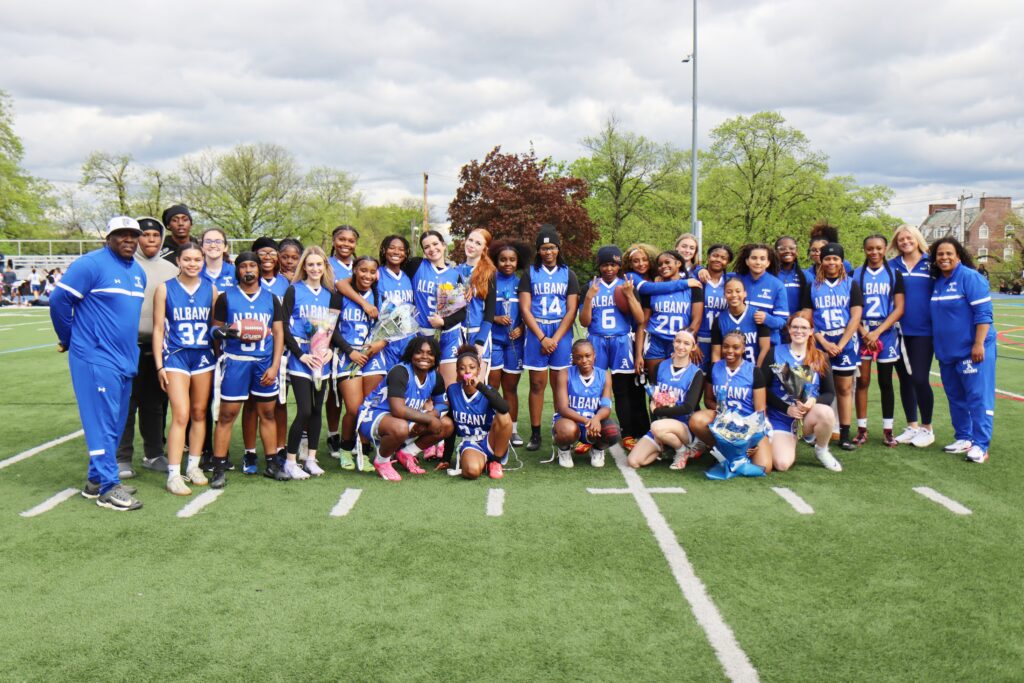Until two years ago, Jaya Stewart had never played a school sport.
Now she’s a championship-winning athlete.
The Albany High senior is a member of the school’s varsity girls’ flag football team, which won the Section II Class A championship last spring against Shenendehowa High School. Like most members of the squad, Stewart was new to the game, though she had played football recreationally with her brother.
“I just wanted to try something new,” says Stewart, who’s a running back on offense and a safety and corner on defense. “I love the people I met. It just makes me want to play even more. I wouldn’t trade it for anything.”
Flag football—a variation of regular football where, instead of tackling, players remove a flag from the ball carrier to end
a down—is one of the fastest-growing sports in the world. Participation has surged in the Capital Region, where it’s a new varsity sport for girls, and opportunities to play for local leagues and youth organizations are on the rise. In the spring of 2026, Russell Sage College will launch the first intercollegiate women’s flag football team in the area.
In 2024, the New York State Public High School Athletic Association (NYSPHSAA) began recognizing flag football as a girls’ high school state championship sport. There are now more than 230 high school girls’ flag teams statewide.
“We haven’t been doing girls’ flag football for very long, and just to see the growth in popularity has been amazing,” says Robert Zayas, executive director of the NYSPHSAA. “It’s been phenomenal to see how many kids are participating.”

At Albany High, 80 girls tried out; 30 made the team. “Every young lady I walked past in the hall was interested,” recalls head coach Decky Lawson. “Once people realized we were going to play flag football here, the news spread like wildfire. Everybody wanted their shot to show their athletic skills.”
Football has long been America’s most popular sport, so perhaps it’s not surprising girls want in on the action. The appeal is simple: Flag football is a lot of fun. “Maybe girls always wanted to play, but the tackle side was intimidating,” says Albany Assistant Coach Rachel Swann. “Once that was removed, they were like ‘OK, it’s my time.’”
Jon Coons, head coach for the flag football team at Saratoga Springs High School, notes that prior to flag becoming a varsity sport, there were only three spring sports for high school girls: lacrosse, softball, and track and field. “There was a demand for another spring sport,” he says.
Coons is also a coach for the Saratoga boys’ football team, which plays in the fall. He decided to coach flag when his daughters said they wanted to play. “It’s awesome that girls can share the sport of football with their brothers or their dad,” he says.
Flag football has gotten a big boost from the National Football League through its NFL FLAG program, the largest youth flag football program in the US. NFL teams cover start-up costs for schools to establish teams, allowing them to purchase equipment and uniforms. The New York Giants provided a $30,000 grant to support Section II teams; in other parts of the state, the New York Jets and Buffalo Bills have stepped up.
This past spring, there were 16 flag football teams competing across Section II, which covers the Capital Region—up from
12 teams in 2024.
Although girls are driving the explosion in flag football at the high school and college levels, there are opportunities for boys to play through clubs and other organizations, too. In the past decade, concerns about the long-term health repercussions of head injuries and concussions have prompted some families to embrace flag as a safer alternative to tackle.
Advocates for flag football predict it will keep growing, as more teams come online and more clubs and rec leagues are formed. “This is something we really want other schools to adopt and potentially implement,” Zayas says, “because we do see that it’s having a positive impact on student athletes.”







